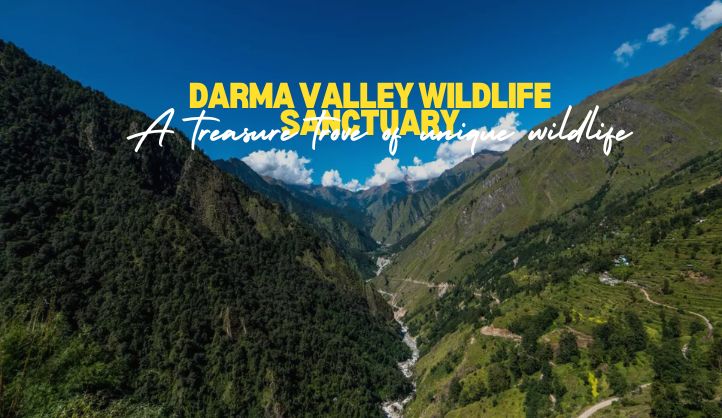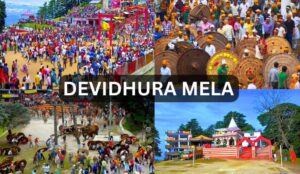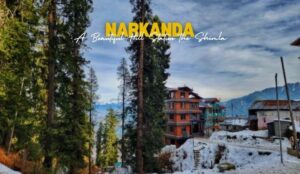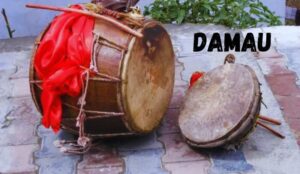Nestled in the stunning Kumaon
region of Uttarakhand, India, the Darma Valley Wildlife Sanctuary is a hidden gem that offers a unique blend of natural beauty, rich biodiversity, and cultural heritage. This sanctuary is not just a haven for wildlife enthusiasts but also a paradise for trekkers and adventurers seeking to explore the less-traveled paths of the Himalayas. With its breathtaking landscapes, diverse flora and fauna, and serene environment, Darma Valley is an ideal destination for those looking to escape the hustle and bustle of urban life.
Geographic and Ecological Overview
Location and Accessibility
Darma Valley lies in the Pithoragarh district, bordered by the Darma River on one side and the majestic peaks of the Panchachuli range on the other. The valley starts near the village of Dave and extends towards the Sino-Indian border. The nearest town is Dharchula, which serves as a gateway to this pristine wilderness. To reach Darma Valley, visitors typically travel by air to Pantnagar Airport, followed by a train or bus journey to Tanakpur Railway Station. From there, shared jeeps or local taxis can take travelers to Dharchula, with further transport options available to reach the valley itself.
Climate and Best Time to Visit
The climate in Darma Valley varies significantly with altitude. Summers (May to June) are mild and pleasant, making it an ideal time for trekking and exploring. The post-monsoon months (September to October) also offer clear skies and vibrant landscapes, perfect for nature photography and wildlife spotting.
Biodiversity of Darma Valley Wildlife Sanctuary
Flora
Darma Valley is home to a rich diversity of plant species, ranging from lush green forests at lower altitudes to alpine meadows as one ascends. Common flora includes:
- Coniferous Trees: Such as deodar (Cedrus deodara) and pine (Pinus spp.)
- Broadleaf Trees: Including oak (Quercus spp.) and rhododendron (Rhododendron spp.)
- Medicinal Plants: Various herbs used in traditional medicine.
The valley’s unique climatic conditions foster an ecosystem that supports both temperate and alpine vegetation, making it a crucial area for conservation efforts.
Fauna
The wildlife sanctuary is renowned for its rich fauna, which includes several endangered species. Notable animals found in the region are:
- Snow Leopard: A symbol of high-altitude ecosystems.
- Himalayan Black Bear: Often seen foraging in lower forested areas.
- Musk Deer: Known for its distinctive musk gland.
- Himalayan Tahr: A type of goat that thrives in steep terrains.
Birdwatchers will also find a variety of avian species, including pheasants, eagles, and migratory birds that visit during specific seasons.
Cultural Significance
Local Communities
The Darma Valley is inhabited by indigenous communities that have lived in harmony with nature for centuries. The primary occupation of these villagers revolves around agriculture and livestock rearing. Crops like buck wheat, potatoes, and peas are commonly cultivated here. The local culture is rich in traditions and folklore, often reflected in their festivals and daily life. Visitors can experience authentic Himalayan hospitality by staying with local families in homestays or guesthouses. This interaction provides insights into their lifestyle, customs, and culinary practices.
Mythology and Legends
Darma Valley holds significant mythological importance as it is believed to be the place where the Pandavas cooked their last meal before ascending to heaven. The five peaks of Panchachuli are named after the Pandava brothers—each peak representing one brother—adding a layer of spiritual significance to this breathtaking landscape.
Trekking Opportunities
Popular Treks
Darma Valley offers several trekking routes that cater to different skill levels:
- Darma Valley Trek: A moderate trek that takes you through picturesque villages, dense forests, and stunning views of the Panchachuli peaks.
- Panchachuli Base Camp Trek: This trek leads adventurers directly to the base camp of Panchachuli, providing panoramic views of the majestic peaks along with opportunities for wildlife spotting.
Trekking in this region not only offers physical challenges but also rewards trekkers with breathtaking vistas and encounters with local wildlife.
Trekking Experience
The trekking experience in Darma Valley is unlike any other. As trekkers navigate through varied terrains—from lush green valleys to rocky paths—they are greeted by seasonal waterfalls, glacial streams, and stunning landscapes that change with elevation. The tranquility of the region allows for moments of reflection amidst nature’s beauty. Accommodations during treks can vary from basic homestays in villages like Dugtu to camping under the stars near scenic spots. Local guides often accompany trekkers, sharing their knowledge about flora, fauna, and cultural heritage along the way.
Conservation Efforts
Importance of Conservation
With increasing tourism pressure and changing environmental conditions, conservation efforts in Darma Valley have become crucial. Protecting its unique biodiversity ensures that future generations can enjoy its natural beauty while maintaining ecological balance. Local organizations and government initiatives focus on sustainable tourism practices that minimize environmental impact while promoting awareness about conservation among visitors.
Community Involvement
Engaging local communities in conservation efforts has proven effective in preserving both culture and nature. By involving them in eco-tourism initiatives, locals gain economic benefits while ensuring that their traditional lifestyles are respected and maintained. Programs aimed at educating visitors about responsible trekking practices also contribute significantly to conservation goals within the sanctuary.
Nearby Places to Explore
1. Dharchula
Dharchula serves as the primary gateway to Darma Valley. This quaint town is located on the banks of the Kali River and offers a glimpse into local life with its bustling markets, traditional food, and handicrafts. Visitors can explore local temples and enjoy the scenic views of the surrounding mountains.
2. Sobla
Sobla is the last motorable village before entering Darma Valley. At an altitude of 1,670 meters, it marks the transition from road travel to trekking. The village is surrounded by lush greenery and offers a peaceful atmosphere for visitors to acclimatize before starting their trek.
3. Panchachuli Base Camp
The base camp offers breathtaking views of the Panchachuli peaks, which are significant in local mythology as the final resting place of the Pandavas. The trek to this camp allows visitors to experience stunning alpine meadows and glaciers.
4. Lassar Yangti Valley
This valley connects with Darma Valley and offers picturesque landscapes filled with wildflowers and dense forests. It’s an excellent spot for trekkers looking for solitude and natural beauty.
5. Kali River
Flowing between India and Nepal, the Kali River is not only a natural boundary but also steeped in local myths and legends. The riverbanks provide serene camping spots for trekkers.
6. Nanda Devi National Park
A Nanda Devi National Park UNESCO World Heritage Site, this national park is home to diverse flora and fauna, including rare species like the snow leopard and Himalayan tahr. The park offers excellent trekking opportunities for nature enthusiasts.
7. Valley of Flowers National Park
Valley of Flowers National Park is famous for its meadows of endemic alpine flowers; this national park is a UNESCO World Heritage Site. The vibrant colors during bloom season attract nature lovers and photographers alike.
8. Munsiyari
Known as the “Gateway to Milam Glacier,” Munsiyari is a charming hill station offering stunning views of the Panchachuli peaks. It’s a popular base for trekkers exploring higher altitudes.
Conclusion
Darma Valley Wildlife Sanctuary stands as a testament to nature’s untouched beauty and cultural richness. Its diverse ecosystems provide a sanctuary not only for wildlife but also for travelers seeking solace away from crowded tourist spots. Whether it’s trekking through its scenic trails, experiencing local culture firsthand, or simply soaking in the serene environment, Darma Valley offers an unforgettable adventure. As awareness grows about this hidden treasure in Uttarakhand, both visitors and locals alike need to prioritize sustainable practices that protect this fragile ecosystem while celebrating its unique heritage. Exploring Darma Valley is not just about witnessing natural beauty; it’s about connecting with nature’s pulse and understanding our role in preserving it for generations to come.
FAQs about Darma Valley Wildlife Sanctuary
1. Where is Darma Valley Wildlife Sanctuary located?
Darma Valley Wildlife Sanctuary is situated in the Pithoragarh district of Uttarakhand, India. It lies in the Kumaon region and is bordered by the majestic Panchachuli peaks.
2. What is the best time to visit Darma Valley?
The best time to visit Darma Valley is from late spring to early autumn (May to October). During these months, the weather is generally pleasant for trekking and wildlife spotting. The post-monsoon period (September to October) also offers clear skies and vibrant landscapes.
3. What unique wildlife can be found in Darma Valley?
Darma Valley is home to several unique species, including:
- Snow Leopard
- Himalayan Tahr
- Musk Deer
- Himalayan Black Bear
- Bharal (Blue Sheep)
- Various bird species like the Himalayan Monal and Cheer Pheasant.
4. How do I reach Darma Valley?
To reach Darma Valley, you can fly to Pantnagar Airport, then take a train or bus to Tanakpur Railway Station. From Tanakpur, shared jeeps or local taxis can take you to Dharchula, which serves as the gateway to the valley.
5. Are there trekking opportunities in Darma Valley?
Yes, Darma Valley offers several trekking routes suitable for different skill levels. Popular treks include the Darma Valley Trek and the Panchachuli Base Camp Trek, both of which provide stunning views and encounters with local wildlife.





